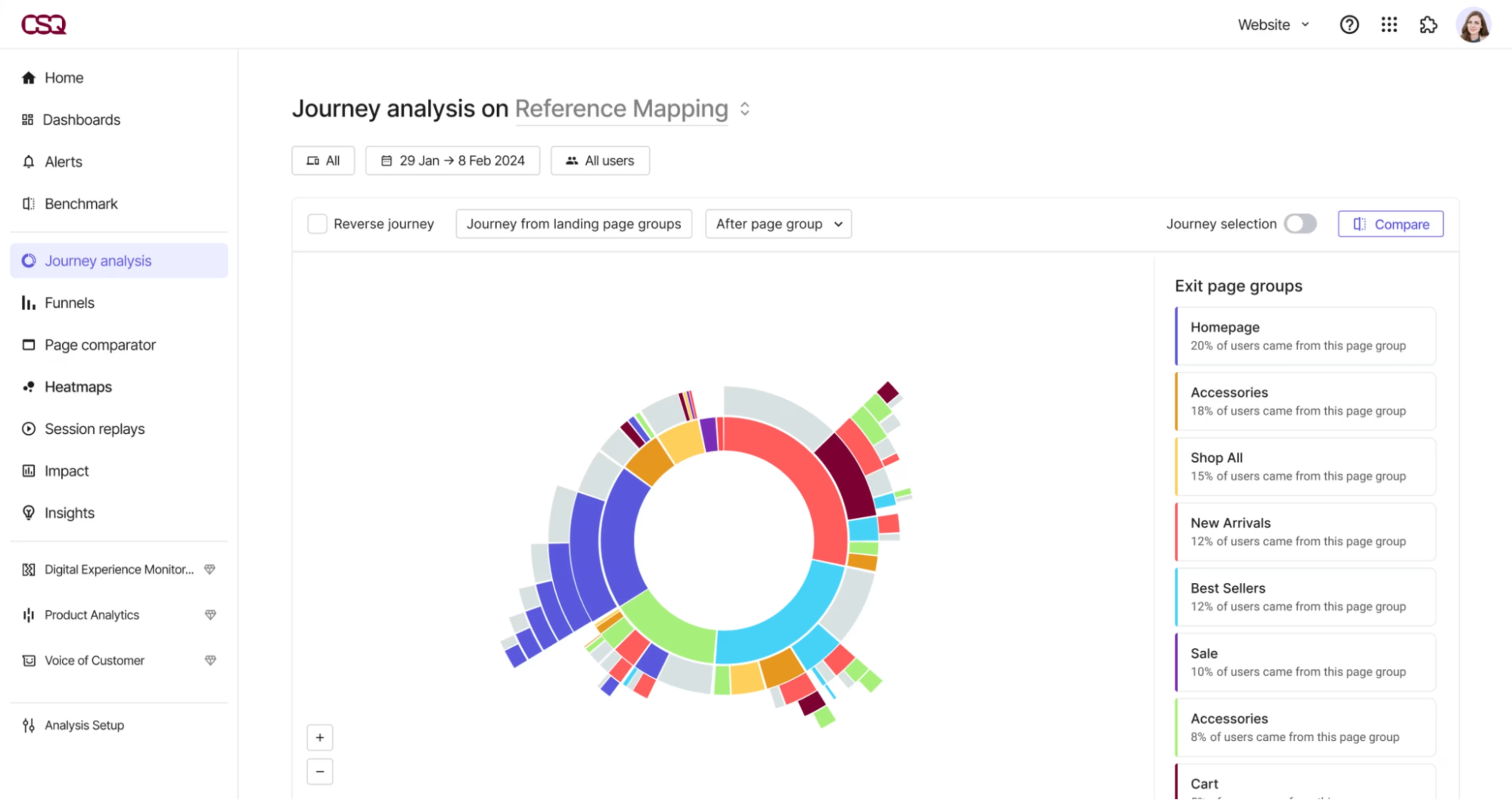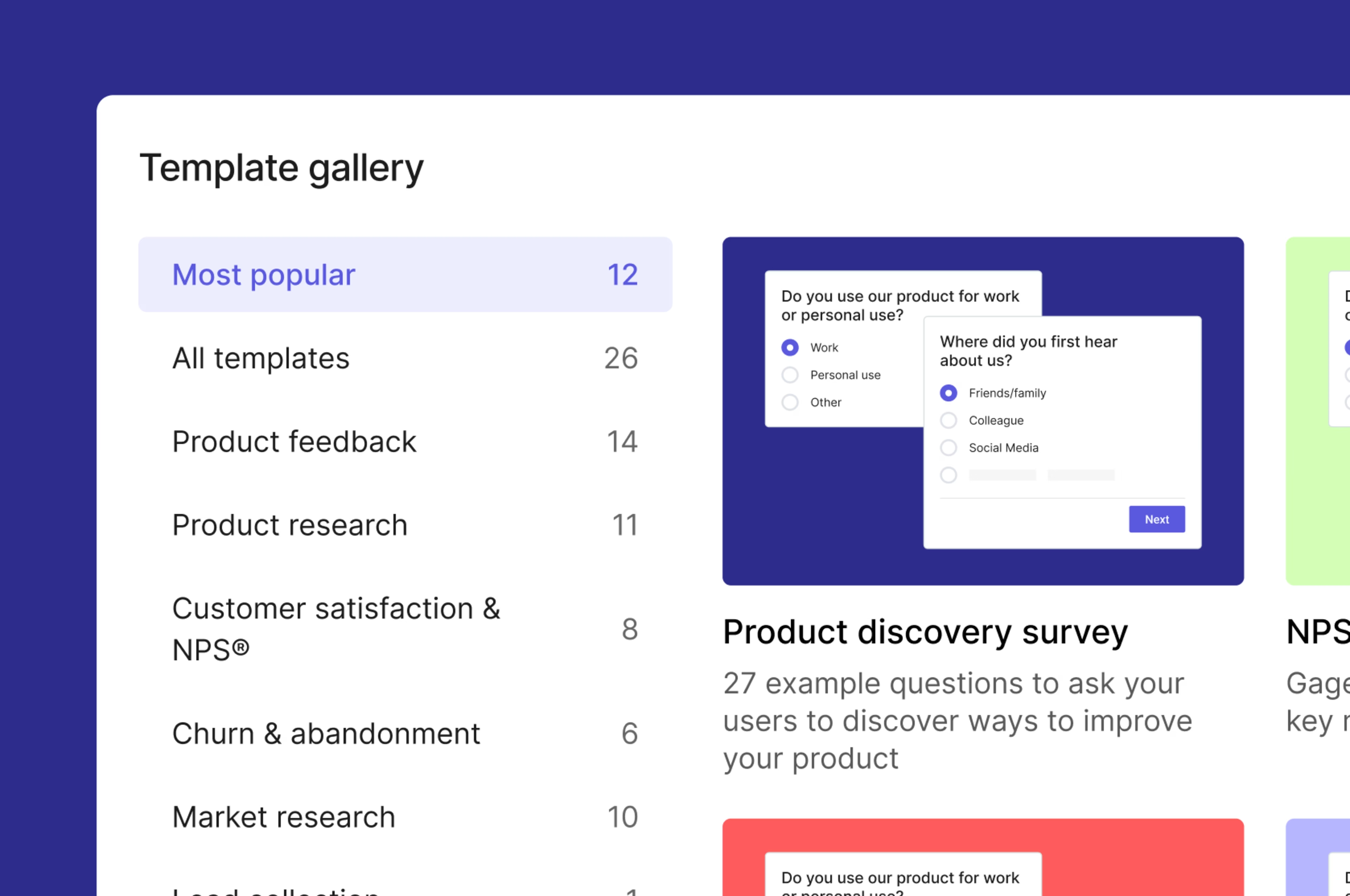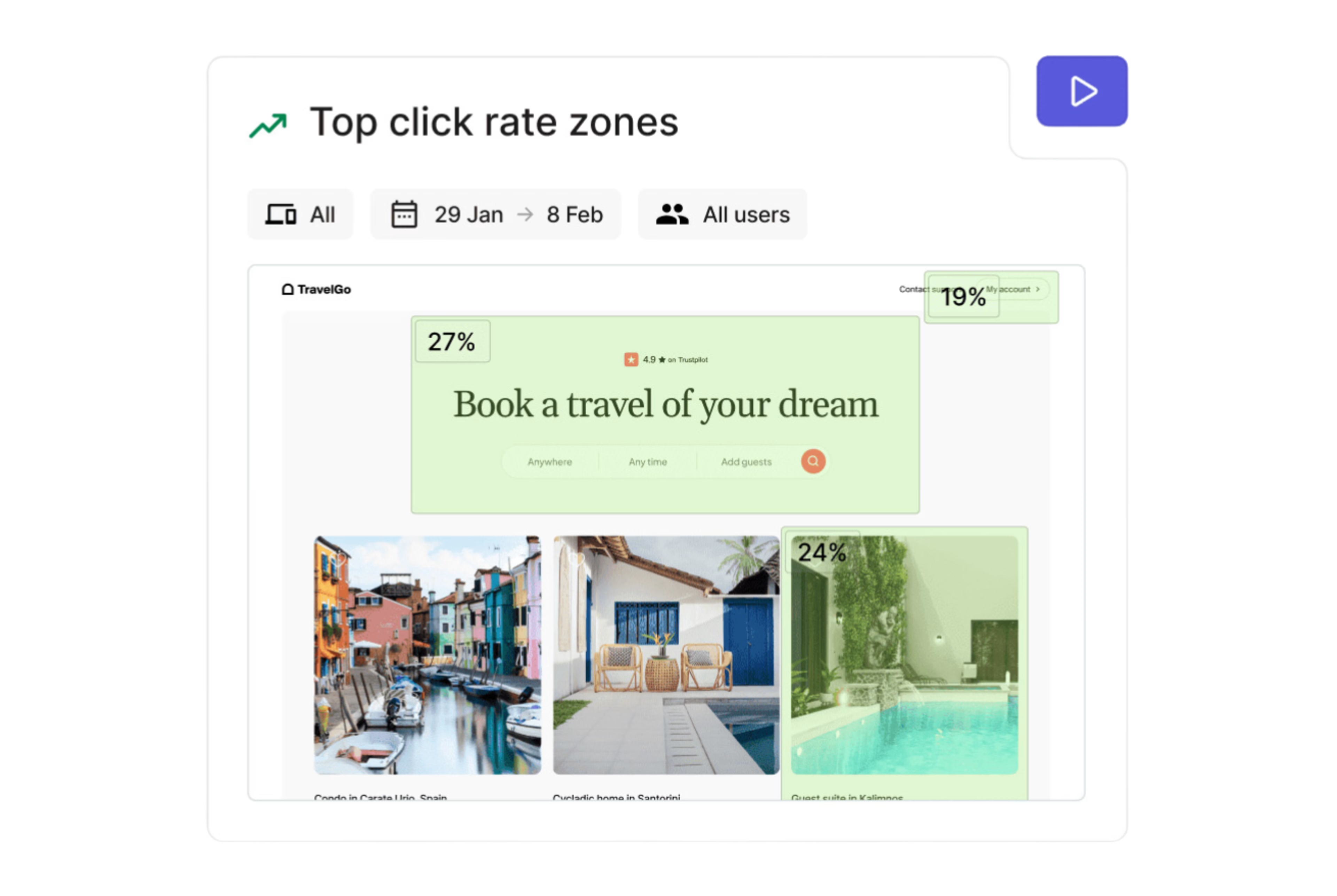Creating a customer journey map puts you in your customers’ shoes to help you understand the user experience—what your users think, feel, and do at each stage of their buying journey.
We’ve put together a list of five brilliant customer journey mapping (CJM) examples to show you how it’s done, so you can learn how to improve the user experience (UX) for your customers.
5 great examples of customer journey mapping
A good customer journey map identifies buyers’ actions, desires, and experiences at every key touchpoint—from when a customer lands on your webpage all the way to conversion, onboarding, and beyond.
Our list of customer journey examples breaks down the best B2B, B2C, ecommerce, and SaaS journey maps—and shows you how to understand your customers better to build your own.
1. Hotjar’s B2B customer journey map
![[Visual] hotjar-sticky note customer-journey-map](http://images.ctfassets.net/gwbpo1m641r7/3K3CA9TQLp5eKAWnJbA1tb/f30c9af2402d57b78bbf19ccf59b1830/hotjar-customer-journey-map.jpeg?w=1920&q=100&fit=fill&fm=avif)
Hotjar’s example of a customer journey map can be created in 2–3 days
Hotjar, now part of the Contentsquare group, made product experience (PX) insights tools to help businesses understand how their customers interact with their websites and digital products. So naturally, the team conducted some B2B customer journey mapping of their own to understand what their customers want by tracking their interactions across key touchpoints.
The result was the digital customer journey example shown above that maps their customers' experience when they use Hotjar tools for product testing. They visualized the key actions, questions, technical limitations, and opportunities of customers using Hotjar tools to get granular data to validate product ideas and experiments.
They started by identifying one specific customer journey, then used Google Analytics, their own Hotjar tools (now available in the Contentsquare platform), and data from customer interactions with their brand to understand user actions, thoughts, and feelings. Then, they got UX, dev, engineering, and customer success teams to fill out empathy maps before mapping the journey.
To increase empathy with their customers, they included two rows dedicated to pain points and happy moments—like the pain of finding patterns in complex customer data, and the ‘aha moment' when their users first realize value.
They made their map flexible enough to be updated as customer needs change and new information becomes available, encouraging them to continually validate their assumptions against customers’ real-world experiences.
The benefits of customer journey mapping included helping them visualize customer motivations, drivers, and pain points, align cross-functional teams, eliminate silos, and clarify which team owns each part of the buyer journey.
How B2B companies selling self-serve digital products can create a similar map
1. Define the goal and scope of your customer journey map
The Hotjar team recommends starting with a narrow scope and only a few people involved. Focus on a specific problem you can break down into a few steps—like identifying where you’re losing users, and mapping out the pains, desires, and experiences of customers who exit your site.
Ask yourself:
What do you want to achieve?
Which customer journey touchpoints do you want to focus on?
What KPIs do you want to measure?
Where can you get the data you need?
Which teams need to be involved?
2. Use Google Analytics or Contentsquare’s Product Analytics and user experience analysis tools to collect insights about online interactions
Create heatmaps on key product pages to see where users are clicking and which parts of your page aren’t engaging users or working as intended. Then, improve UX and optimize the placement of on-page elements to boost conversions.
Use session replays to see how users scroll, click, and move around your site across an entire session. Focus on spotting bugs and blockers that cause them to bounce.
3. Add qualitative user data
Input information from Voice of Customer (VoC) tools like surveys, user tests, and user interviews. You can also include data from service chat logs, emails, or by asking customer support teams.
4. Create an empathy map
Get key product and customer service teams to fill in an empathy map detailing what your buyers do, say, see, hear, think, and feel. (Feel free to steal the free template below!)
![[Visual] hotjar-empathy-map-template](http://images.ctfassets.net/gwbpo1m641r7/qbIQswXTwKldTgCtZzKSC/060bc332a6e934b15691cc34021db15d/hotjar-empathy-map-template.jpeg?w=1920&q=100&fit=fill&fm=avif)
Mapping empathy is a crucial part of customer journey mapping
5. Map the journey
Use Post-its and pens to fill in your map before digitizing it and sharing it across the company.
Pro tip: follow our easy six-step guide to create your own customer journey map—or get even faster insights with customer journey analysis in Contentsquare.
Journeys reveals how users progress through your site from beginning to end. Get intuitive visualizations of common paths, looping behaviors, and drop-offs, then zoom in with session replays to understand what really happened—and how you can improve the experience.

Journeys aggregates 100% of user data to show you common paths and inform your customer journey mapping process
2. Rail Europe’s B2C journey map
![[Visual] Rail Europe customer journey map](http://images.ctfassets.net/gwbpo1m641r7/1HnpMysnwzIQxgWO2YgXOV/dfd711733f7fada5c119a708bf41bfd5/Rail_Europe_customer_journey_map.jpeg?w=1920&q=100&fit=fill&fm=avif)
Rail Europe’s customer journey map includes interactions before, during, and after a trip
B2C ecommerce travel provider Rail Europe gives customers an easy way to book rail tickets online. Their on-site user interface (UI) is strong, but the company wanted to go deeper to understand the customer journey across all touchpoints.
Mapping the customer journey produced a full spectrum customer experience map that illustrates the buyer's journey before, during, and after a purchase. It reminded their team that the buyer journey starts long before a customer lands on the website to book a ticket—and continues after the trip, through touchpoints like post-trip refunds, sharing recommendations, or publishing photos on social media.
Rail Europe’s customer journey map also shows the transition between stages or channels to accurately visualize what is often a non-linear journey. For example, in the initial research, planning, and shopping phases, customers often move back and forth between comparison pages, checking timetables, and website chat and planning features.
Mapping the journey like this helps Rail Europe understand different customers’ channel preferences, see which touchpoints aren’t working as they should, and which aspects of the user experience need more attention from design teams, marketing, and customer support. They visualized actions, thoughts, feelings, and experiences and rated the customer satisfaction of each stage, as well as the relevance and helpfulness of Rail Europe, to home in on areas for improvement.
The map doubles down on customer empathy by identifying travelers’ overall concerns and frustrations while on the trip, even those unrelated to their rail journey—the overall travel experience is still connected with the company brand in customers’ minds.
This stand-alone map can be understood across teams without supporting materials, and there’s a focus on actionable insights—like the need to address customer frustrations over snail mail ticket delivery.
Ecommerce website analysis like this is valuable for any company selling experiential products or services, like concert tickets, vacations, or tours. If that’s you, follow Rail Europe’s example and conduct customer journey map research by surveying current and potential customers to uncover exactly what they’re hoping for, thinking, and feeling as they engage with your brand.
Tips to map out the ecommerce customer journey
1. Ask yourself:
How can we access users who aren’t yet customers?
What happens before the customer gets to our web page? How do they do research for a trip? What kinds of search keywords do they use online?
Is the buyer journey linear or non-linear? How can we represent this?
2. If your buyer journey has multiple touchpoints, group them into categories (like 'research and planning', 'shopping', and 'booking').
3. Match survey insights to touchpoints and map out the journey visually, adding qualitative insights about what the customer is thinking, feeling, and doing at each stage.
Pro tip: use Surveys to collect real-time suggestions about your website or app from users to make data-driven decisions and validate assumptions that inform and elevate your customer journey map.

Choose from Contentsquare’s survey template gallery or let AI generate the right questions based on your research goals
3. Rewind’s SaaS customer journey map
![[Visual] Rewind-SaaS-customer-journey-map](http://images.ctfassets.net/gwbpo1m641r7/55YM3RtPTB0IfdPLQPb8YH/babb7d40fc7bc6734cea5586e5acf0da/Rewind-SaaS-customer-journey-map.jpeg?w=1920&q=100&fit=fill&fm=avif)
Rewind’s customer journey map visualizes the full B2B purchase process before the customer even gets to their website
Rewind makes backup and restoration software for SaaS platforms. Their team decided to map out the B2B SaaS customer journey when revenue fell short of expectations after the acquisition of a similar product. It also became clear that marketing efforts weren’t attracting the ideal customer.
Like many SaaS companies, Rewind relied on sales calls and customer relationship management (CRM) data to understand their users. But they were missing key insights about what happens before the customer lands on their website.
To map the journey, the Rewind team defined their ideal customer profile (ICP) before conducting customer interviews to deeply understand buyer motivations and the decision-making process. They also used Google Analytics, Hubspot, and PX insights tools to understand users’ online behavior and how they were interacting with marketing materials.
This showed them a short, high-intent, back-and-forth customer journey that happens almost exclusively online—since Rewind is installed in SaaS platforms, a lot of traffic is referred from their app marketplaces.
The map showed event triggers and the customer’s thoughts and feelings as they moved through becoming aware of their problem (loss of important data), understanding the need for a solution, and doing online research—before arriving at Rewind.
By mapping the full journey, the Rewind team discovered that customers often use professional forums or communities as part of solution research, and discovered a new buyer motivation and market segment: data compliance.
According to Content Lift Founder Ryan Paul Gibson, who helped Rewind conduct customer interviews, the company also realized “potential buyers don’t want to speak with sales or ‘get a demo'. They want to research the product themselves and evaluate it. They also don’t want to enter a credit card to test it; they want to try it first and pay if it’s a good fit.”
Rewind updated their go-to-market strategy, personas, product positioning, and marketing to complete these missing steps in the customer journey map.
The result? A two-fold increase in product installations, and better internal alignment on their ICP—which has improved their efficiency and helped them maximize resources.
![[Visual] After mapping the customer journey, Rewind produced much more targeted landing pages](http://images.ctfassets.net/gwbpo1m641r7/7CZeLlsD1t3uKGaSkbkoFP/a4e6777f5fa065df5a2f50633240e84f/-Visual-_After_mapping_the_customer_journey__Rewind_produced_much_more_targeted_landing_pages.jpg?w=1920&q=100&fit=fill&fm=avif)
After mapping the customer journey, Rewind produced much more targeted landing pages
How to create a great SaaS customer journey map
1. Set your research objectives.
2. Create a list of topics that align with your ideal buyer journey. For example, in Rewind’s case, they were customers’ reasons for buying, details about their company and role, and what caused them to start searching for a solution.
3. Create questions to ask customers during interviews, but leave flexibility for discussion.
4. Run in-depth customer interviews using a tool like Contentsquare. Invite existing customers to participate or select from our diverse pool of candidates to get fresh perspectives and ensure you get the insights you need. Use these interview sessions to capture the exact order of events in the buyer journey and make sure you understand every customer action and touchpoint—from users identifying a problem to making a purchase.
5. Bucket interview insights into user priorities, pains, and anxieties—what happened to trigger a search; which research channels the customer uses; how they evaluate solutions.
4. Spotify’s B2C customer journey map
![[Visual] Spotify customer journey map](http://images.ctfassets.net/gwbpo1m641r7/6P1bTjrUReELo4m4MFnhnz/a06a9785ee27a4a95fc8928163396b40/Spotify_customer_journey_map.jpeg?w=1920&q=100&fit=fill&fm=avif)
Spotify’s user flow map focuses on one feature only
When music streaming app Spotify mapped the user journey, their team focused on tracking touchpoints for one specific feature: sharing playlists via third-party apps.
Their map zeroes in on clearly defined user personas and identifies key areas of customer engagement with a focus on users’ emotions and thoughts at each stage.
The team’s journey mapping research revealed a key customer pain point—fear of being judged for their music taste—that can hold users back from sharing music. They also identified an awareness gap to address: some users didn’t know the feature existed.
By mapping the user journey, Spotify improved their UI and in-app flows to streamline the customer experience and make every touchpoint relevant to how real customers use the product.
Mapping user flows is key for digital B2C brands with a product that lives and dies by good usability—and a business model that relies on customer loyalty.
How to map the user journey before improving or launching a feature
1. Conduct market research based on direct and indirect competitors to understand how people use similar features, and what they expect from yours.
2. In user interviews, focus on the specific feature or stage of the journey. Why aren’t customers using it as you’d like? What are the barriers to product adoption? Dig deep into what motivates users to complete a specific action—and what blocks them.
3. Using interview data, create a buyer persona and include their key needs and motivations. What can you do to bring this feature to their attention and boost adoption?
4. Create a customer journey map combining stages in the user’s interaction with the feature, and break down the actions they take and the thoughts and emotions they have at each stage.
5. Use these insights to remove friction and improve user flows, validating your design with real users.
Pro tip: combine your user interview research with session replays and heatmaps to get even more insights into user experiences at every stage in the customer journey.

Heatmaps show you an intuitive aggregated view of which parts of your site are attracting attention and which aren’t to help you make changes that improve UX—and surface issues you can explore further in user interviews
5. Emirates Airline’s multi-channel customer journey map
![[Visual] Emirate Airline customer journey map](http://images.ctfassets.net/gwbpo1m641r7/3rEvtyjRBfUsjpNbm0Wm2Z/faabfb1510be01de2c8fdf7fccec74ec/Emirate_Airline_customer_journey_map.jpeg?w=1920&q=100&fit=fill&fm=avif)
Emirates does a good job of mapping a complex, multi-channel customer journey
To reflect their customers’ multi-channel journey, flag carrier Emirates created a CJM that covers reservations, check-in, and onboarding experiences.
As well as digital channels, the map includes call center interactions, which provide context for interactive voice response (IRV) technology and human service agents. It also sheds light on customer desires, broken down into categories like ‘comfort’, ‘safety’, ‘confidence’, and ‘freedom and control’, shown in the corners of the map.
With a global brand like Emirates, customers expect the same experience at all touchpoints, in all countries. This exercise helped the Emirates team understand customers’ main interactions and expectations to better coordinate service touchpoints and provide a consistent, high-quality experience across each one.
For example, they set up a single, virtual contact center platform to increase efficiency and ensure consistent interactions across every channel. It’s not just the customer who benefits: the Emirates team now better understands exactly how to meet user needs across several channels and countries.
This map is ideal for businesses whose customer journey combines online and offline touchpoints, especially companies looking to differentiate themselves through the quality of their service.
How to implement a multi-channel customer journey map
1. Define your key goals for producing the map.
2. Conduct thorough market research and customer interviews to reduce your assumptions and understand every single interaction and channel that customers experience.
3. Interview customer experience and support staff members at all touchpoints and in all regions.
4. Use experience analytics tools and product analytics software to understand how buyers interact with your digital marketing, website, and chat functions across channels and locations.
5. Use AI to analyze customer insights (like your Voice of Customer feedback) for better, faster decision-making.
Pro tip: Contentsquare AI unlocks actionable insights from even the most complex data, enabling you to make user-centric optimizations without the need for analyst involvement. Surface key metrics automatically so you’re always on top of issues that affect the customer experience, and use Chat with Sense to get personalized advice that helps you get the most from your data.
![[Visual] contentsquare-ai-copilot](http://images.ctfassets.net/gwbpo1m641r7/29iJrvXcmjtSWRXWq6uhtg/4ae293b3513c3e434241c0ef2acaf992/contentsquare-ai-copilot.jpeg?w=1200&q=100&fit=fill&fm=avif)
Contentsquare’s Chat with Sense assistant gives you actionable insights from quantitative and qualitative customer data
You’ve reached your destination: a truly valuable customer journey map
Customers interact with your brand over a variety of channels and touchpoints, and their journeys aren’t always linear. But understanding their journey is key to improving your product and boosting customer acquisition, adoption, and retention.
Follow these customer journey mapping examples to experience key touchpoints from your users’ point of view and grasp their pains, needs, and frustrations so you can build a journey your customers will love.

![[Visual] Contentsquare's Content Team](http://images.ctfassets.net/gwbpo1m641r7/3IVEUbRzFIoC9mf5EJ2qHY/f25ccd2131dfd63f5c63b5b92cc4ba20/Copy_of_Copy_of_BLOG-icp-8117438.jpeg?w=1920&q=100&fit=fill&fm=avif)